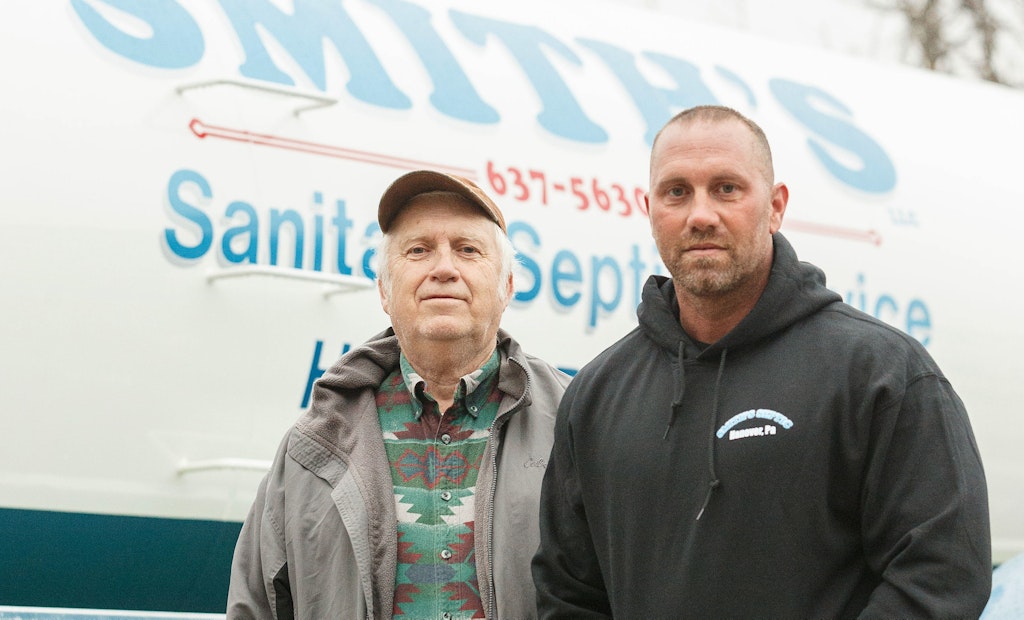
Steve Smith and his son Steve Smith, owners of Smith's Sanitary Septic Service (Photo by James Robinson)
Interested in Disposal?
Get Disposal articles, news and videos right in your inbox! Sign up now.
Disposal + Get AlertsSeptic pumpers encounter a variety of disposal issues. Sometimes treatment plants raise their rates, put limits on pumpers, or prohibit you from unloading certain types of waste. Distance can be another issue, and the extra time and transportation costs associated with hauling waste can add up quickly.
Looking for an alternative to unloading septage at the local township’s treatment plant, Smith's Sanitary Septic Service invested $2.5 million in its own treatment facility. Located in Hanover, Pennsylvania, the facility is equipped with three underground tanks situated on a 340-acre corn and alfalfa farm where the waste is spread. A lease agreement with a neighbor increases the acreage to a combined 600 acres for spreading.
Owner Steve Smith says operating his own waste treatment facility has its pros and cons. The single biggest advantage is convenience. Smith's Sanitary Septic Service is no longer bound by anyone else’s schedule; drivers can unload any time they’d like.
A second advantage is the ability to handle waste the township doesn’t accept. For example, Smith's Sanitary Septic Service diversified its business by processing food waste.
As for the bottom line, Smith says purchasing the $1.5 million farm, installing the tanks and buying the necessary equipment is a long-term investment.
“We’re roughly into this for $2.5 million, counting all costs. From a financial standpoint, way down the road, it could be a financial benefit,” he says.
Justifying the cost was something Smith considered before opening his own facility.
“It definitely is geared toward a larger operation because a lot of your expense — your permitting, your engineering — is the same whether you have one truck or nine, like we do,” Smith says.
Doing it by the books
The initial permitting process was lengthy, time-consuming, and expensive, according to Smith. Building multiple pits with special liners and purchasing treatment and spreading equipment added to the expense. Although Smith doesn’t want to discourage companies from building their own facilities, he urged them to be ready for potential challenges from the local government and neighbors.
“You typically are going to run into a lot of resistance,” he says. Smith says it was tough to be in a legal dispute with the locals, and it took a long time for the issue to settle down.
“Everyone wants their garbage gone when they set it out front. Everyone wants someone to come over when they want their septic tank pumped, but man, when it comes to finding an outlet for it, nobody wants any part of it,” he says.
Working to Smith’s advantage was the remoteness of the farm where they set up operations.
“We are very fortunate that our property is surrounded only by other farms. For our general area, we are about as rural as it gets.”
Smith chuckles at the notion that he’s become a farmer, but in reality, he now has two separate operations. “It certainly upped our workload tremendously,” he says.
Using their own treatment facility requires more time and effort than they previously spent at the public treatment facility.
“At the treatment plant, our work ended right there when we dumped. Obviously, here we’re treating and we’re land-applying,” Smith says.
If companies aren’t willing to put in a fair amount of extra time, Smith suggests they don’t open their own facilities. “You definitely need to accept the fact that this is going to be pretty time-consuming.”
For Smith, the disadvantages of owning a waste treatment facility are balanced by the advantages, like the capability to handle diverse waste and 24/7 unloading.
“You can come in and dump anytime you like, which is important.”





